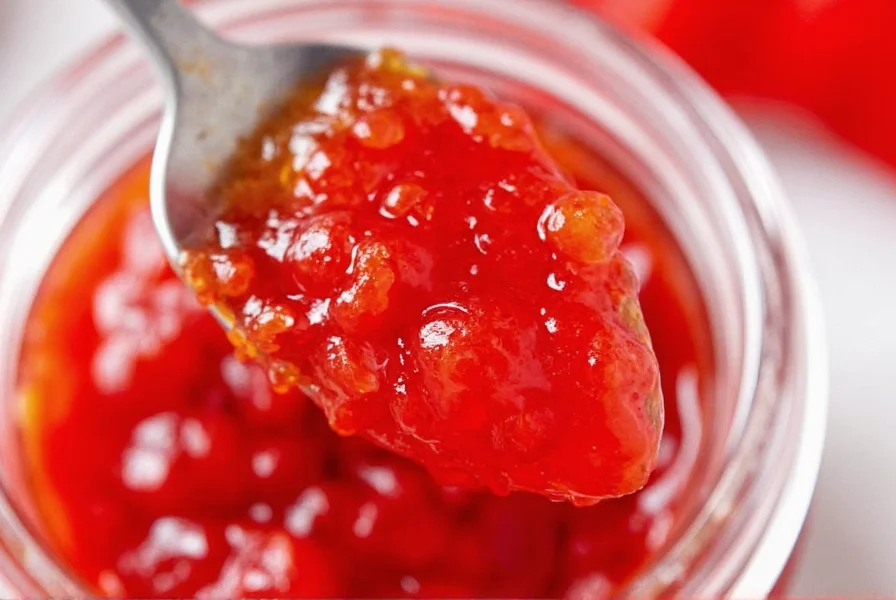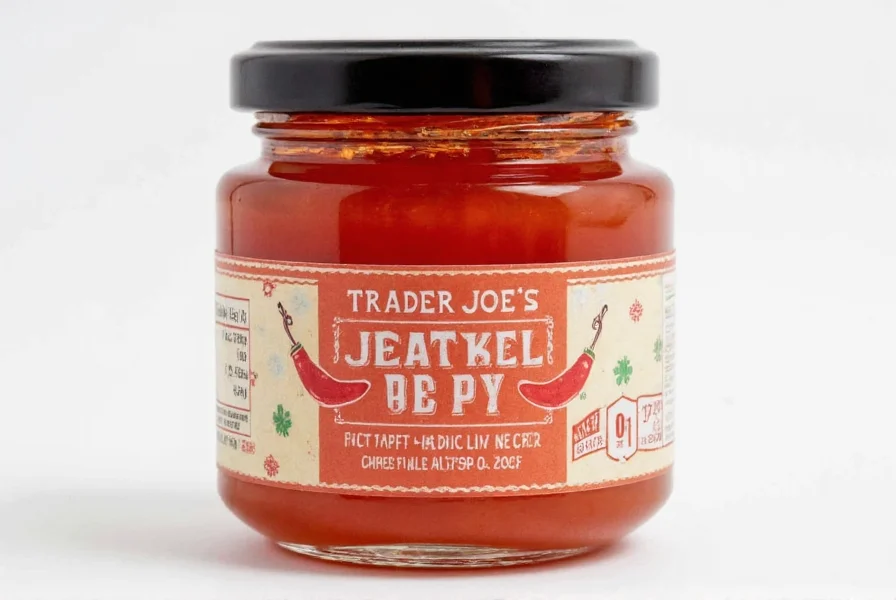For home cooks seeking versatile pantry staples, Trader Joe's pepper jelly delivers remarkable culinary flexibility. This bright red condiment has gained a loyal following since its introduction, becoming one of the grocery chain's most requested items. Understanding its composition and applications helps maximize its potential in everyday cooking.
Understanding Trader Joe's Pepper Jelly Composition
Examining the ingredient list reveals why this product stands out in the crowded condiment market. The primary components include red bell peppers, jalapeño peppers, sugar, distilled vinegar, and natural pectin. Unlike many commercial pepper jellies that rely on artificial flavors or excessive preservatives, Trader Joe's version maintains a relatively clean ingredient profile.
Nutritionally, each two-teaspoon serving contains approximately 50 calories, 13 grams of carbohydrates, and 10 grams of sugar. The absence of artificial colors means the vibrant red hue comes naturally from the peppers. This clean formulation appeals to consumers increasingly scrutinizing food labels for unnecessary additives.

Flavor Profile and Culinary Characteristics
The distinctive taste of Trader Joe's pepper jelly strikes a careful balance between sweet and spicy elements. The initial sweetness from the sugar content gives way to a moderate heat level that builds gradually. This progression makes it accessible to those with varying heat tolerances while still delivering the characteristic kick expected from a pepper-based product.
Compared to similar products in the market, Trader Joe's version offers a more pronounced pepper flavor rather than overwhelming sweetness. The texture is smooth yet substantial enough to cling to foods, making it equally effective as a dipping sauce or a cooking ingredient. This versatility explains its popularity among both casual cooks and experienced home chefs.
Practical Applications in Everyday Cooking
While many consumers initially purchase Trader Joe's pepper jelly for cheese pairings, its culinary applications extend far beyond this traditional use. The jelly's balanced flavor profile makes it an excellent base for glazes, marinades, and sauces that benefit from both sweetness and heat.
| Application | Recommended Pairing | Preparation Tip |
|---|---|---|
| Meat glaze | Pork tenderloin, chicken wings | Thin with equal parts soy sauce for balanced flavor |
| Cheese accompaniment | Cream cheese, brie, goat cheese | Chill jelly before serving for cleaner slices |
| Sauce base | Stir-fries, roasted vegetables | Mix with rice vinegar for dipping sauce |
| Baking ingredient | Glazed ham, meatballs | Combine with mustard for complex flavor |
Recipe Ideas Featuring Trader Joe's Pepper Jelly
Transforming this pantry staple into impressive dishes requires minimal effort. One popular preparation involves creating pepper jelly meatballs by combining one cup of jelly with 1/2 cup of Dijon mustard and 1/4 cup of soy sauce. Simmer this mixture with frozen meatballs for 20 minutes for an effortless party appetizer that consistently receives rave reviews.
For a sophisticated main course, try the pepper jelly glazed salmon. Mix equal parts jelly and orange marmalade with a splash of rice vinegar. Brush this mixture onto salmon fillets during the final 5-7 minutes of baking at 400°F. The result features a beautiful caramelized crust with complementary sweet and spicy notes that enhance rather than overwhelm the fish.

Storage Recommendations and Shelf Life
Proper storage significantly impacts the longevity and quality of Trader Joe's pepper jelly. Unopened jars maintain peak quality for 12-18 months when stored in a cool, dark pantry. Once opened, refrigeration becomes essential—store the jar with its lid tightly sealed to prevent crystallization and flavor degradation.
Refrigerated opened jars typically remain at their best for 3-4 months. To extend usability, consider dividing larger quantities into smaller containers, minimizing repeated exposure to air with each use. Always use clean utensils when serving to prevent contamination that could shorten shelf life.
Dietary Considerations and Allergen Information
For consumers with specific dietary requirements, Trader Joe's pepper jelly offers several advantages. The product is certified gluten-free, making it suitable for those managing celiac disease or gluten sensitivity. Additionally, it's completely vegan, containing no animal products or byproducts.
The jelly does contain significant sugar content, which may concern those monitoring their carbohydrate intake. However, its concentrated flavor means small amounts deliver substantial taste impact, potentially reducing overall sugar consumption compared to using multiple condiments. Those with nightshade sensitivities should note the primary ingredients include both bell peppers and jalapeños.
Availability and Purchasing Information
Trader Joe's pepper jelly maintains consistent availability across most store locations, though seasonal variations occasionally affect stock levels. The standard 11-ounce jar typically retails between $3.99 and $4.99, representing excellent value compared to specialty food stores where similar products often cost $8-$12.
During peak holiday seasons, some locations may experience temporary shortages due to increased demand for cheese platter components. For those unable to visit physical stores, limited online availability exists through select grocery delivery services, though prices often include premium delivery fees that substantially increase the per-ounce cost.
Comparing Trader Joe's Version to Alternatives
When evaluating Trader Joe's pepper jelly against competitors, several distinguishing factors emerge. Compared to Williams-Sonoma's version, Trader Joe's offers a more pronounced pepper flavor with less overwhelming sweetness at approximately half the price. The texture also tends to be slightly thicker, providing better cling when used as a glaze.
Homemade versions require significant time investment and ingredient sourcing, typically taking 2-3 hours to prepare small batches. While customization is possible with homemade versions, the consistent quality and convenience of Trader Joe's product make it a practical choice for regular use. Specialty brand versions often contain additional ingredients like fruit juices that alter the fundamental flavor profile.
Practical Tips for Maximizing Flavor Impact
Experienced users have discovered several techniques to enhance the culinary potential of Trader Joe's pepper jelly. When using it as a glaze, thinning with equal parts vinegar or citrus juice creates a more complex flavor profile while reducing excessive sweetness. For cheese boards, allowing the jelly to come fully to room temperature before serving releases its full aromatic potential.
Freezing small portions in ice cube trays then transferring to freezer bags provides convenient single-use portions for recipes. This method prevents waste from partially used jars that might otherwise spoil before finishing. When incorporating into sauces, adding the jelly during the final stages of cooking preserves its bright flavor rather than allowing it to dissipate during prolonged heating.
Frequently Asked Questions
Is Trader Joe's pepper jelly gluten-free?
Yes, Trader Joe's pepper jelly is certified gluten-free. The product contains no wheat, barley, rye, or other gluten-containing ingredients, making it safe for individuals with celiac disease or gluten sensitivity.
How long does Trader Joe's pepper jelly last after opening?
Once opened, Trader Joe's pepper jelly should be refrigerated and will maintain best quality for 3-4 months. Always use clean utensils when serving to prevent contamination that could shorten its shelf life.
Can I use Trader Joe's pepper jelly as a substitute for other pepper jellies in recipes?
Yes, Trader Joe's pepper jelly works as a direct substitute for other pepper jellies in most recipes. Its balanced sweet-heat profile makes it particularly versatile. When substituting in recipes calling for milder varieties, you may want to reduce the amount by 25% to account for its pronounced pepper flavor.
What's the best way to use Trader Joe's pepper jelly with cheese?
For optimal cheese pairing, allow the pepper jelly to come to room temperature before serving. It pairs exceptionally well with cream cheese, brie, and aged cheddar. A recommended ratio is one tablespoon of jelly per two ounces of cheese. For entertaining, consider creating a layered cheese ball with cream cheese and a generous topping of the jelly.
Does Trader Joe's pepper jelly contain artificial preservatives?
No, Trader Joe's pepper jelly does not contain artificial preservatives. The product relies on sugar and vinegar for preservation, along with natural pectin as a thickening agent. This clean ingredient approach contributes to its popularity among consumers seeking minimally processed food options.











 浙公网安备
33010002000092号
浙公网安备
33010002000092号 浙B2-20120091-4
浙B2-20120091-4